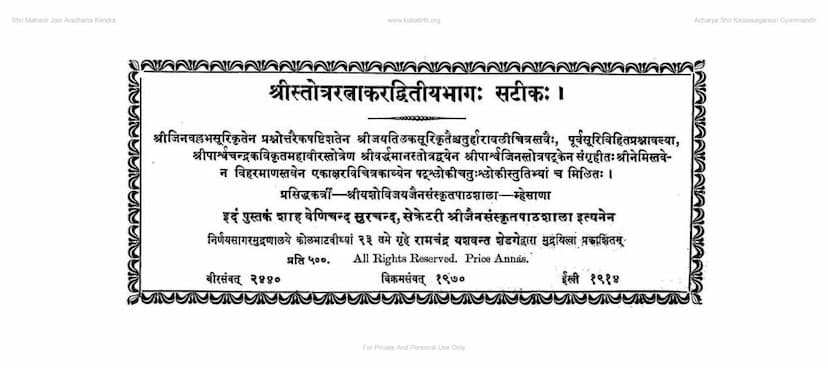Stotra Ratnakar Satik Part 02
Added to library: September 2, 2025

Summary
This is a comprehensive summary of the provided Jain text, "Stotra Ratnakar Satik Part 02" by Jinvallabhsuri, published by Yashovijay Jain Sanskrit Pathshala. The summary is based on the content of the provided pages.
Book Title: Stotra Ratnakar Satik Part 02 Author: Jinvallabhsuri Publisher: Yashovijay Jain Sanskrit Pathshala, Mehsana
Overall Purpose and Content: This volume, "Stotra Ratnakar Satik Part 02," is a collection of various Jain stotras (hymns of praise) compiled and presented with commentaries (atikas/savuri) by different esteemed Jain scholars and poets. The introduction (Upoḍghātaḥ) highlights the purpose of this compilation: to provide rich spiritual and philosophical content in Sanskrit, making it accessible to a wide audience for study and contemplation. The text emphasizes the beauty, depth, and devotional essence of these stotras, which are considered a way to nourish the soul and attain spiritual strength, inspired by the teachings of Lord Mahavir.
Key Stotras and Their Content (as detailed in the Upoḍghātaḥ and Anukramaṇikā):
The book is a repository of numerous stotras, each unique in its composition, style, and the deity it praises. The core components of this volume are:
-
Shri Jinvallabhsuri's Prashnottar Ekashashti Shatak (61 Question-Answer Stotras):
- This is the first and a significant part of the compilation.
- The unique feature of this work is that each shloka is posed as a question, and the answers are provided in the commentary.
- The stotras are described as "chitrakaavya" (picture poetry) adorned with various "chitra-alankaras" (pictorial figures of speech) like "Shrinkhala" (chain), "Mandhana" (churning), "Ashtadala kamala" (eight-petaled lotus), "Padma" (lotus), and their variations. These intricate poetic structures are visually represented through "Jati Chakra" (pattern cycles) in the text.
- The commentary explains the complex wordplay and philosophical nuances within each verse.
-
Shri Jaytilak Suri's Chaturhaaravali Chitrastava (Four-Segmented Pictorial Stotras):
- This section presents four "Chaturvimsatika" (sets of 24 verses, referring to Tirthankaras) for past, future, present, and eternal Tirthankaras.
- Each shloka praises two Tirthankaras with deep devotion.
- A unique aspect is the "Akshara Grahaṇa" (letter capture) where the first and last letters of the four lines of a verse, when taken in sequence, reveal the names of the two Tirthankaras being praised. This is described as a "chitra-bandha" (pictorial ligature).
- The commentary provides detailed explanations of the Tirthankaras and the intricacies of the poetic structure.
-
Purva Suri Vihita Prashnavali (Questions by Earlier Acharyas):
- This refers to a collection of questions posed by previous learned scholars.
- The commentary is detailed ("Chavuri Shalini") and the answers are woven into 12-lettered verses ("Dvadashaksharyam").
-
Gayaraya Stotra (Stotra of the Elephant King):
- This stotra is described as "Aadi Padavyapadeshya" (the first mentioned).
- It is in Prakrit language, accompanied by a Sanskrit commentary ("Savachurik Chaturthata").
- It is noted for its "Yamakapada Samniveshita" (placement of rhyming words) and its overall beauty.
-
Shri Parshva Chandra Kavi's Mahavir Stotra:
- This stotra is composed by Shri Parshva Chandra Kavi and has a commentary by Shri Bhavaprabha Suri.
- It is noted for its "Sarasvata Samjna Adhikara Sutra Sankalita Padamaya" (verses compiled from Sarasvata grammar rules).
-
Shri Vardhaman Stotra Dvaya (Two Stotras for Lord Vardhamana):
- These stotras are composed by Shri Surachandra, a disciple of Acharya Vineya.
- They are presented with commentaries.
-
Shri Parshva Jina Stotra Shathaka (Six Stotras for Lord Parshvanatha):
- This section includes six stotras dedicated to Lord Parshvanatha.
- It is described as "Samaasayam" (having compilations).
-
Shri Nemi Stave:
- A stotra dedicated to Lord Neminatha.
- It is characterized by its brevity, using only two letters ("Namarupe Nijadviyakshara Matra Khachita").
-
Viharamana Stave (Stotras for Tirthankaras in Current Existence):
- This section likely refers to stotras praising Tirthankaras who are currently living or will manifest. The commentary is provided.
-
Ekakshara Vichitra Kavya (One-Lettered Pictorial Poetry):
- This is a unique poetic composition where each verse is formed using only one letter, but the verses convey four different meanings related to Arhanatha, Brahma, Vishnu, and Maheshvara. This highlights the profound semantic potential of Sanskrit words.
-
Shat-Shloki and Chatur-Shloki Stutis:
- These are collections of six-verse and four-verse hymns, respectively, dedicated to the Bhagavan (Lord).
- The stotras are characterized by "Dvikhara Trivyanjana Ashrita" (based on two consonants and three vowels) and "Yamakalankaramayi" (filled with the Yamaka poetic device).
Key Features of the Publication:
- Commentaries (Satika/Savachurik): A significant aspect of this work is the inclusion of detailed commentaries by learned scholars, making the intricate meanings and poetic devices understandable.
- Pictorial Poetry (Chitra Kavya/Jati Chakra): The text extensively utilizes and explains various forms of "Chitra Kavya" or "Jati Chakra," where verses are structured in specific patterns resembling lotuses, wheels, etc. These are a testament to the linguistic and artistic prowess of the authors.
- Linguistic Depth: The commentaries delve into the grammatical rules (like Panini's Ashtadhyayi), etymology, and philosophical interpretations of the Sanskrit and Prakrit words used in the stotras.
- Devotional Content: The primary purpose remains devotional, expressing profound love and reverence for the Tirthankaras.
- Accessibility: The publisher's aim is to make these valuable texts accessible through printing, keeping them affordable.
- Preservation of Tradition: The publication by Yashovijay Jain Sanskrit Pathshala signifies a commitment to preserving and disseminating Jain religious literature and scholarship.
In essence, "Stotra Ratnakar Satik Part 02" is a scholarly and devotional compilation that showcases the depth of Jain literature through a rich collection of stotras, elaborate commentaries, and sophisticated poetic structures, all aimed at spiritual upliftment and understanding.